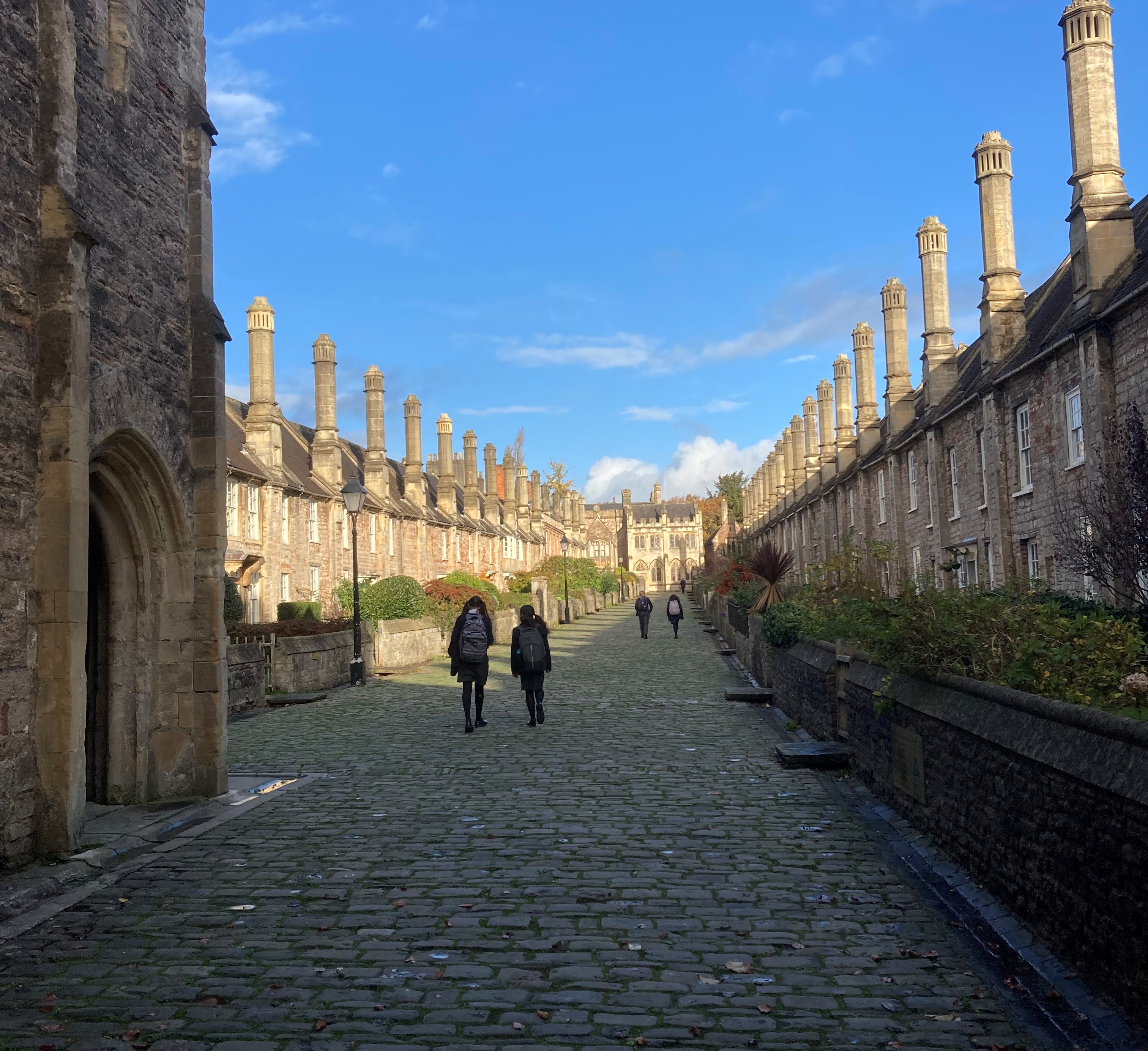Vicars' close

|
| This is the view from the southern end of vicars' close, looking from the wider portion of the street (entering from the cathedral) towards the chapel at the narrower end. |
Contents |
[edit] Introduction
Vicars’ close is a medieval stone street in Wells. With its original buildings intact, it is thought to be the oldest entirely residential street in England. Some believe it is the oldest surviving residential street in all of Europe.
[edit] History
Built for Bishop Ralph of Shrewsbury, vicars’ close was founded in the 1300s. The project was made possible through a grant from Walter de Hulle.
As the canon of the adjacent Wells cathedral, de Hulle provided an endowment that funded the construction of dedicated accommodations for the chantry priests (specifically referred to as vicars choral) whose job was to provide singing for services held in the cathedral eight times a day. Prior to the construction of the close, the chantry priests lived throughout the town. Through the efforts of Bishop Ralph, it became possible to offer them simple two-storey private houses - first referred to as the college or close of the vicars - near the cathedral.
[edit] Vicars’ hall
In 1348, the first part of the project, the vicars’ hall, was completed. Located at the south end of the close, the hall included a store room, bakehouse, offices and treasury with a first floor communal dining room above.

|
| The chain gate is a Grade I listed building made from Doulting stone ashlar with a Welsh slate roof. |
In 1459, the chain gate was built adjacent to the hall. The arched gate, which was placed at the entrance to the close, included a covered walkway between the hall and the cathedral.
[edit] Homes
Construction of the 42 identical residences - one for each vicar - may have been completed in two phases. The earliest of the sandstone structures is thought to date as far back as 1363; the rest of the homes were completed by 1412.
The homes were initially built to a set plan. Above the modest ground floor hall was an upper floor of the same size; both had fireplaces in their front walls. The back door opened up to a small yard with washing facilities; a latrine was situated under the stairway in the back of the house.
[edit] Chapel
The next significant addition to the close was the vicars’ chapel (containing the library), which was constructed at the north end between 1424 and 1430. Made primarily from rubble masonry, the building has two floors. The lower floor serves as the chapel, and a spiral staircase leads to the library above.
While the close is noteworthy for its symmetry, this is not the case with the chapel. It is slightly out of alignment due to the incorporation of the remains of an existing structure within the construction of its northern wall.
[edit] Changes brought on by the Reformation
Before the Reformation, there were 22 houses on the east side and 20 on the west. This quadrangle formation was possibly the prototype for others built later, including those found at Oxford and Cambridge colleges.
Funding for changes to the homes came from money provided by Bishop Thomas Beckington, who left much of his estate to the vicars' choral. Repairs and improvements in the mid-15th century included unified roof terraces, lead pipes to bring water into the houses and the iconic high chimneys. Front gardens were also added, which converted the central part of the quadrangle into a roadway.
After the Reformation, significant modifications were made to vicars’ close. Because members of the clergy were permitted to marry, the homes needed to be modified to accommodate larger households. Walls were knocked through and extensions were added to the back gardens. Eventually, the two parallel rows of two room homes were converted. By 1592, the 42 original homes became 14.
[edit] The deceptive street
The disruption of the quadrangle facilitated the construction of the stone street running between the two rows of homes. This came roughly 100 years after the homes and hall were complete and other changes had already been made to the close.
The street is paved with setts rather than cobblestones. Setts are rectangular stones, usually made of granite, that can be arranged in various decorative ways with different patterns and colours.
Inside the close, the street is about 140m long and 10m wide - at some points. While the length is obviously constant, the width is not.

|
| From northern end of the close by the chapel, this is the view looking towards Wells cathedral. |
The width decreases by 3m as it stretches from the entrance by the hall down to the chapel, creating a false perspective. Because the houses at the north end are closer together than those at the southern end, the road looks longer for those approaching from the cathedral than it does for those approaching from the chapel end.
[edit] The modern close
The 14th century close continues to serve its original purpose, still providing homes for the 12 members of the vicars’ choral along with organists and other members of the musical community who support Wells cathedral.
The homes - 27 in total - have been modified, but many have been well preserved and are Grade I listed.
The chapel is used by the Wells Cathedral School.
[edit] Related articles on Designing Buildings
IHBC NewsBlog
Images from inside a Grade II listed hotel show the scale of its collapse
The Corbett Arms in Tywyn has fallen into serious disrepair.
Old Sarum fire in listed (& disputed) WW1 Hangar - Wiltshire Council has sought legal advice after fire engulfed a listed First World War hangar that was embroiled in a lengthy planning dispute.
UK Antarctic Heritage Trust launches ‘Virtual Visit’ website area
The Trust calls on people to 'Immerse yourself in our heritage – Making Antarctica Accessible'
Southend Council pledge to force Kursaal owners to maintain building
The Council has pledged to use ‘every tool in the toolbox’ if urgent repairs are not carried out.
HE’s Research Magazine publishes a major study of the heritage of England’s suburbs
The article traces the long evolution of an internal programme to research 200 years of suburban growth
IHBC Context 183 Wellbeing and Heritage published
The issue explores issues at the intersection of heritage and wellbeing.
SAVE celebrates 50 years of campaigning 1975-2025
SAVE Britain’s Heritage has announced events across the country to celebrate bringing new life to remarkable buildings.
IHBC Annual School 2025 - Shrewsbury 12-14 June
Themed Heritage in Context – Value: Plan: Change, join in-person or online.
200th Anniversary Celebration of the Modern Railway Planned
The Stockton & Darlington Railway opened on September 27, 1825.
Competence Framework Launched for Sustainability in the Built Environment
The Construction Industry Council (CIC) and the Edge have jointly published the framework.














